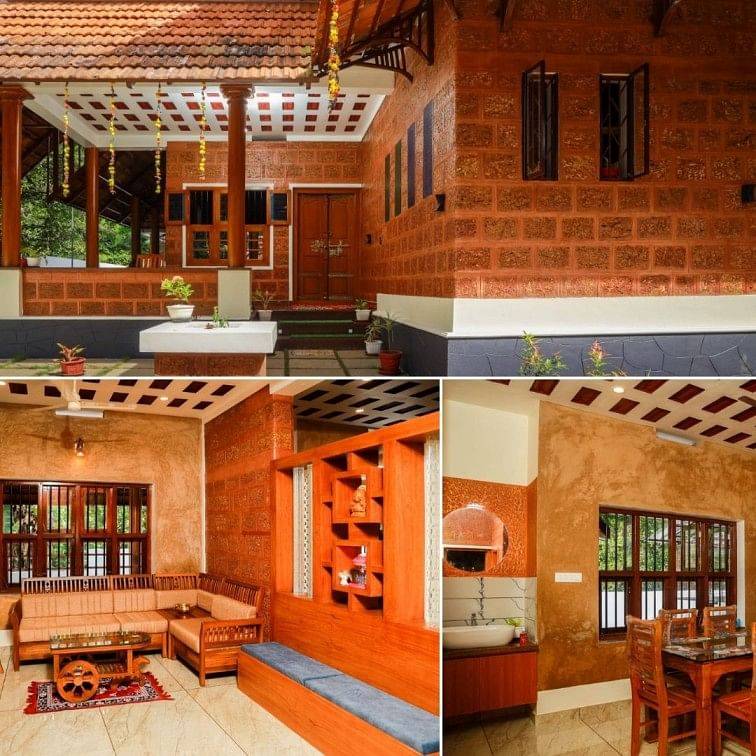
Dinesh Kumar, a Sub-Engineer at the Thrissur Corporation, was looking for something nostalgic when it came to building his new home.
"I've always wanted a house constructed with traditional architecture, like the ones I saw in my childhood, but with all the modern amenities.
Homes were built using eco-friendly materials and methods in ancient times, which we wanted to explore as well," Dinesh explained.
Shantilal a designer and engineer at the Centre of Science and Technology for Rural Development (COSTFORD) who had built several such eco-friendly projects.
The house, which is close to Dinesh's ancestral home in Meloor, was created utilizing traditional Kerala architecture and various eco-friendly and indigenous techniques. The house has four bedrooms, a kitchen with an adjacent work area, a pooja room, a dining room, a balcony, and a multi utility space in a total area of 2,700 sqft.
"The walls were created using locally sourced laterite stones, which are naturally produced and have been an important component of Kerala's traditional architecture since ages," Shantilal added. There was no cement or mortar used. To bind the laterite stones, we instead used a blend of natural materials such as sand and lime. During construction, river sand and soil were fully avoided." The complex walls were also constructed using laterite stones.
Shantilal said the plastering of the laterite walls has been done using a unique mixture of natural materials.
"We mud plastered most of the walls of the house. It was done by integrating a variety of organic and natural elements with sand.
We added rice husk, which has high fiber content and hence contributes strength. Apart from that, we mixed jaggery, fenugreek, 'kadukka' (terminalia chebula), and lime with sand. As a plaster, all of these elements contribute strength to the walls, and 'kadukka' aids in the prevention of insects and termites. This type of plastering offers a natural texture to the walls and a traditional appeal to the house."
"However, we did utilize cement plastering in a few spots, such as kitchen and bathrooms, because they are prone to moisture risk," he added.
Certain areas in the house have been left un-plastered, which serves as a wonderful design element. "We utilized a water-based paint with a glossy finish. The house's exterior has been left un-plastered, revealing the laterite stones," Shantilal said.
In addition to natural materials, several sustainable and cost-effective techniques, such as the filler slab, were employed in the construction of the house.
"We used clay roof tiles in between the concrete," Shantilal said. It minimizes the strain on the roof as well as the amount of concrete, and it provides superior thermal insulation. All the clay tiles were reused ones. The mud plastering, in conjunction with this method, helps to keep the house naturally cool," he explained.
Dinesh claimed that the house is cooler than a typical concrete house built using traditional procedures. "When we walk into the house, we notice a difference. Most of the time, we don't use fans," he explained.
The house also has a light well — a courtyard in the center of the house which has a grille and a glass ceiling on top. It helps provide sunlight through the day, Dinesh notes.
Another eye-catching feature is the house's balcony, which was inspired by Kerala's ancient temple theatre structure. "It's created in the model of a 'koothambalam,' a traditional temple theatre for exhibiting Koothu, an ancient ritualistic art form of Kerala," added Shantilal. The balcony has a grille constructed of steel rather than wood. But, to make it appear more authentic, we painted it with a wood-like paint." Dinesh claimed that his wife and two children use the balcony as a study and utility area.
"All the windows, doors, and other wood-required pieces were created utilizing reused or old wood procured from Mysore," he added.
The kitchen is spacious and modern, with a multi-wood finish and an adjacent work area. The flooring of the house is made of vitrified tiles.
Dinesh claims that the house was built on a 'pocket-friendly' budget of Rs.35 lakh. I believe the whole cost, including raw materials and labor costs, is significantly lower than the cost of building a conventional concrete house of the same size," he added.











